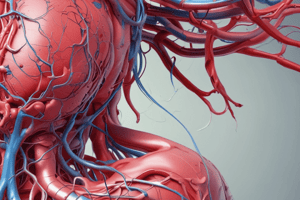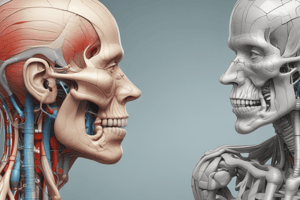Podcast
Questions and Answers
Which bones are involved in the formation of the orbit?
Which bones are involved in the formation of the orbit?
- Mandible and part of temporal bone
- Maxilla and part of temporal bone (correct)
- Zygomatic bone and mandible
- Premaxilla and zygomatic bone (correct)
Which nerve is responsible for the sensation of the face?
Which nerve is responsible for the sensation of the face?
- Mandibular branch of trigeminal nerve (V) (correct)
- Glossopharyngeal nerve (IX)
- Superior laryngeal branch of vagus nerve (X)
- Facial nerve (VII)
Which nerve is responsible for the innervation of the larynx?
Which nerve is responsible for the innervation of the larynx?
- Superior laryngeal branch of vagus nerve (X) (correct)
- Glossopharyngeal nerve (IX)
- Facial nerve (VII)
- Recurrent laryngeal branch of vagus nerve (X) (correct)
Which of the following bones is not part of the orbital cavity?
Which of the following bones is not part of the orbital cavity?
Which nerve is responsible for the sensation of the tongue?
Which nerve is responsible for the sensation of the tongue?
What is the function of the central processes of bipolar receptor cells in the olfactory system?
What is the function of the central processes of bipolar receptor cells in the olfactory system?
What is the term for the unmyelinated fascicles that transmit olfactory information?
What is the term for the unmyelinated fascicles that transmit olfactory information?
How many fila olfactoria are present on each side of the nasal cavity?
How many fila olfactoria are present on each side of the nasal cavity?
What is the structure through which fila olfactoria pass?
What is the structure through which fila olfactoria pass?
What type of cells have central processes that traverse the cribriform plate?
What type of cells have central processes that traverse the cribriform plate?
What is the primary region where the majority of fibers of the olfactory tracts terminate?
What is the primary region where the majority of fibers of the olfactory tracts terminate?
Which structure receives collateral fibers from the lateral olfactory striae?
Which structure receives collateral fibers from the lateral olfactory striae?
What is the course of the lateral olfactory striae?
What is the course of the lateral olfactory striae?
What is the function of the terminal fibers that project to the thalamus?
What is the function of the terminal fibers that project to the thalamus?
Which brain region receives fibers from the lateral olfactory striae that are distinct from the prepiriform area and amygdala?
Which brain region receives fibers from the lateral olfactory striae that are distinct from the prepiriform area and amygdala?
Flashcards are hidden until you start studying
Study Notes
Bones Involved in Swallowing
- The premaxilla, maxilla, zygomatic bone, part of the temporal bone, and mandible are the bones involved in swallowing.
Nerves Involved in Swallowing
- The mandibular branch of the trigeminal nerve (V) plays a role in swallowing.
- The facial nerve (VII) is involved in swallowing.
- The glossopharyngeal nerve (IX) is another nerve involved in swallowing.
- The superior laryngeal branch of the vagus nerve (X) participates in the swallowing process.
- The recurrent laryngeal branch of the vagus nerve (X) is also involved in swallowing.
Transethmoidal Segment
- The central processes of bipolar receptor cells synapse with the olfactory bulb after traversing the cribriform plate.
- Hundreds of central processes traverse the cribriform plate as unmyelinated fascicles, termed fila olfactoria.
- Fila olfactoria are actually olfactory nerves, with each side of the nasal cavity having approximately 20 fila olfactoria.
Intracranial Olfactory Pathways
- The lateral olfactory striae is formed by the majority of fibers from the olfactory tracts
- The lateral olfactory striae course over the insula to the prepiriform area (anterior to the uncus) and amygdala
- Collaterals are given to the subfrontal or frontal olfactory cortex on the way to the prepiriform area
- Fibers project to the subthalamic nuclei with collaterals and terminal fibers to the thalamus and stria medullaris
Studying That Suits You
Use AI to generate personalized quizzes and flashcards to suit your learning preferences.




